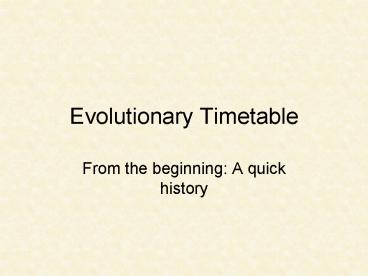Evolutionary Timetable PowerPoint PPT Presentation
1 / 17
Title: Evolutionary Timetable
1
Evolutionary Timetable
- From the beginning A quick history
2
- Although anthropologists study hominids (in
particular Homo sapiens), we must still examine
within the context of time and evolution - change through time.
- The human species as we know it has inhabited the
Earth for only 2 million years, about 0.04 of
the Earths history and 0.01 of the estimated
history of the universe.
3
- Big bang
- Was it really a bang?
- Age of the universe is thought to be around 13-19
billion years old - For our purposes we will say 15 billion.
- We can measure the age of the universe by
examining the red shift. - Current evidence suggests that the universe began
in a single location (called singularity).
4
- This speck began to expand and event called the
Big Bang. - Not necessarily an explosion but more like a
balloon rapidly expanding. - Within 3 minutes after the beginning of the Big
Bang protons and neutrons formed and joined to
make atomic nuclei. - It took another 100,000 years for electrons to
join the nuclei for form atoms.
5
- By 12 bya galaxies had begun to form as gravity
pulled matter together. - About 5 bya the universe (as we know it) was 2/3
present. - 4.3 bya our solar system was formed. Earth came
500 million years later. - By 3.8 bya life was established.
- We know this indirectly from fossils found in
Greenland, southern Africa, and Australia. - About 2 bya complex single-celled organisms
containing nuclei and organelles evolved.
6
- 1.7 bya multicellular organisms first appear
- Bacteria and fungi are dating to about 1.2 bya
- About 543 mya, in the Cambrian period, complex
multicellular organisms burst on the scene. - This event is so sudden that it is called the
Cambrian Explosion. - In 5 million years all major body plans of
multucellular animals had evolved, including
ancestors for vertebrates. - By 425 mya fish had evolved and plants and
animals began to colonize the land. - Insects appear 400 mya
- Reptiles appear 350 mya
- Mammals 256 mya
7
(No Transcript)
8
(No Transcript)
9
(No Transcript)
10
Geological Eras
- Paleozoic
- The first vertebrates appeared 500 m.m.y.a.
- Mesozoic
- Reptiles were dominant land vertebrates.
- Placental mammals appeared 70 m.Y.A.
- Cenozoic
- Divided into two periods Tertiary and Quaternary
and 7 epochs Paleocene, Eocene, Oligocene,
Miocene, Pliocene, Pleistocene and Holocene.
11
Geological Time Scale
12
Geological Time Scale
13
Drifting Continents and Mass Extinctions The
Pace of Change
- During this time, life was not the only thing
evolving on earth. - The earth itself was evolving as the continents
changed shape and positions - This is known as continental drift, which
operates through the process of plate tectonics. - The earth is divided into 16 plates.
14
Continental Drift
- The drift of the plates across the surface of the
earth has been going on over millions of years,
which still changes the outward appearance of the
earth. - When you look at the map of the world, you see
how well the east coast of North and South
America fits into the west coast of Europe and
Africa. - Over millions of years these continents have
slowly drifted apart.
15
- By the time of the dinosaurs and early mammals,
all the continents had drifted together to form a
huge supercontinent we call Pangea, which
literally means all lands. - Around 200 mya, Pangea began to break apart.
- The resulting landmasses were the ancestors of
our present day continents. - They have drifted over the globe
- As they drifted the created numerous
environmental zones causing some species to
become extinct while allowing others to flourish.
16
- About 65 million years ago the dinosaurs were the
dominant form of land animals. - Then one day, an asteroid, thought to measure 6
miles in diameter crashed through the earths
atmosphere and into the crust where the north
coast of the Mexican Yucatan is now. - The impact made a crater 200 miles in diameter.
- The blast of the asteroid was like a nuclear
bomb. - The environmental change was disastrous.
- Dinosaurs became extinct, along with every other
species of land animals weighing more than 55
pounds. - Cretaceous/Tertiary (K/T) extinction
- Mammals adaptive radiation was rapid and
happened with in about 20 million years. - By this time all of the major types of mammals we
know today appeared.
17
(No Transcript)

